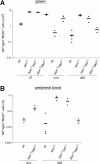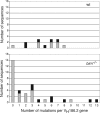Proapoptotic BH3-only protein Bim is essential for developmentally programmed death of germinal center-derived memory B cells and antibody-forming cells
- PMID: 17720882
- PMCID: PMC2190612
- DOI: 10.1182/blood-2007-05-091306
Proapoptotic BH3-only protein Bim is essential for developmentally programmed death of germinal center-derived memory B cells and antibody-forming cells
Abstract
T cell-dependent B-cell immune responses induce germinal centers that are sites for expansion, diversification, and selection of antigen-specific B cells. During the immune response, antigen-specific B cells are removed in a process that favors the retention of cells with improved affinity for antigen, a cell death process inhibited by excess Bcl-2. In this study, we examined the role of the BH3-only protein Bim, an initiator of apoptosis in the Bcl-2-regulated pathway, in the programmed cell death accompanying an immune response. After immunization, Bim-deficient mice showed persistence of both memory B cells lacking affinity-enhancing mutations in their immunoglobulin genes and antibody-forming cells secreting low-affinity antibodies. This was accompanied by enhanced survival of both cell types in culture. We have identified for the first time the physiologic mechanisms for killing low-affinity antibody-expressing B cells in an immune response and have shown this to be dependent on the BH3-only protein Bim.
Figures






Similar articles
-
BH3-only protein Noxa regulates apoptosis in activated B cells and controls high-affinity antibody formation.Blood. 2012 Feb 9;119(6):1440-9. doi: 10.1182/blood-2011-09-378877. Epub 2011 Dec 5. Blood. 2012. PMID: 22144184
-
Puma cooperates with Bim, the rate-limiting BH3-only protein in cell death during lymphocyte development, in apoptosis induction.J Exp Med. 2006 Dec 25;203(13):2939-51. doi: 10.1084/jem.20061552. Epub 2006 Dec 18. J Exp Med. 2006. PMID: 17178918 Free PMC article.
-
Loss of the pro-apoptotic BH3-only Bcl-2 family member Bim sustains B lymphopoiesis in the absence of IL-7.Int Immunol. 2009 Jun;21(6):715-25. doi: 10.1093/intimm/dxp043. Epub 2009 May 19. Int Immunol. 2009. PMID: 19454543 Free PMC article.
-
The unique biology of germinal center B cells.Immunity. 2021 Aug 10;54(8):1652-1664. doi: 10.1016/j.immuni.2021.07.015. Immunity. 2021. PMID: 34380063 Review.
-
B cell memory and the role of apoptosis in its formation.Mol Immunol. 2011 Jun;48(11):1301-6. doi: 10.1016/j.molimm.2010.10.026. Epub 2010 Dec 7. Mol Immunol. 2011. PMID: 21144588 Review.
Cited by
-
Exit from germinal center to become quiescent memory B cells depends on metabolic reprograming and provision of a survival signal.J Exp Med. 2021 Jan 4;218(1):e20200866. doi: 10.1084/jem.20200866. J Exp Med. 2021. PMID: 33045065 Free PMC article.
-
Activation-induced cytidine deaminase and aberrant germinal center selection in the development of humoral autoimmunities.Am J Pathol. 2011 Feb;178(2):462-71. doi: 10.1016/j.ajpath.2010.09.044. Am J Pathol. 2011. PMID: 21281778 Free PMC article. Review.
-
Fipronil Triggers Immunotoxicity Through Reactive Oxygen Species-Driven Mitochondrial Apoptosis in Thymocytes.Toxics. 2025 Mar 12;13(3):204. doi: 10.3390/toxics13030204. Toxics. 2025. PMID: 40137531 Free PMC article.
-
MEK/ERK-mediated phosphorylation of Bim is required to ensure survival of T and B lymphocytes during mitogenic stimulation.J Immunol. 2009 Jul 1;183(1):261-9. doi: 10.4049/jimmunol.0803853. J Immunol. 2009. PMID: 19542438 Free PMC article.
-
Bcl-2-regulated cell death signalling in the prevention of autoimmunity.Cell Death Dis. 2010 Jun 3;1(6):e48. doi: 10.1038/cddis.2010.27. Cell Death Dis. 2010. PMID: 21364654 Free PMC article. Review.
References
-
- Tarlinton D. Germinal centers: form and function. Curr Opin Immunol. 1998;10:245–251. - PubMed
-
- Kelsoe G. Life and death in germinal centers (redux). Immunity. 1996;4:107–111. - PubMed
-
- Lanzavecchia A, Sallusto F. Progressive differentiation and selection of the fittest in the immune response. Nat Rev Immunol. 2002;2:982–987. - PubMed
-
- Manz RA, Hauser AE, Hiepe F, Radbruch A. Maintenance of serum antibody levels. Annu Rev Immunol. 2005;23:367–386. - PubMed
Publication types
MeSH terms
Substances
Grants and funding
LinkOut - more resources
Full Text Sources
Other Literature Sources
Molecular Biology Databases

